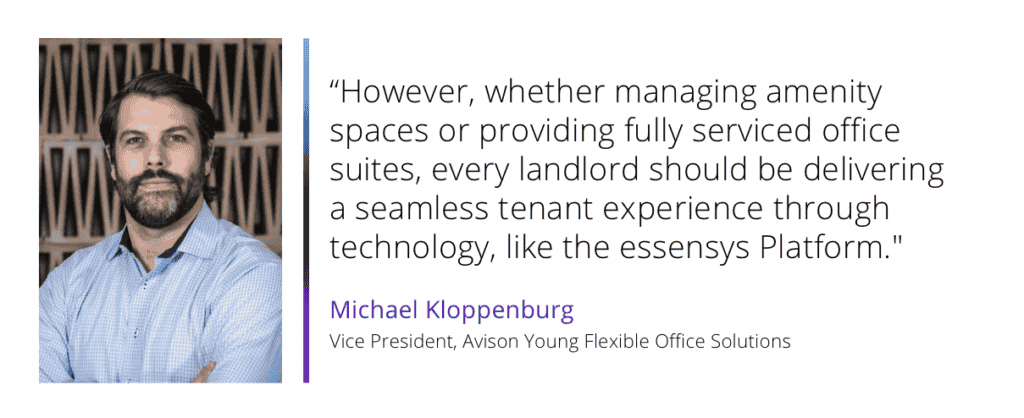Table of Contents
Michael Kloppenburg, Vice President of Flexible Office Solutions at Avison Young, shares his insights on flexible workspaces, as part of our series into the buildings of the future.
What are the biggest challenges facing the flexible workspace market today?
In the near-term, the biggest challenges facing the flexible workspace market are reflective of issues faced in the broader commercial real estate sector. Office asset values are declining, capital markets are constrained by rising interest rates, and investors are reluctant to deploy discretionary funds for new projects. Therefore, it is incredibly difficult to get “net new” flex deals done in this market.
To compound the macro-economic factors, there remains an incongruence between the desired deal structures of flex operators and those required by landlords and their lenders. Alternative structures such as management, revenue, or profit-sharing agreements are intended to enhance alignment, but in many cases the two sides are getting pushed further apart. Whether due to lending requirements, securitization, or the perceived risk of bringing flex to an asset, it is an uphill battle for operators. Growth is still happening, but it takes a bulletproof business case, alignment between all stakeholders, and risk tolerance to pursue a flex operation in this environment.
So where are the opportunities?
Strong operators are finding creative ways to grow by taking over existing flex locations that have closed for one reason or another. For example, repurposing former coworking spaces in historically good office markets at reduced prices, often from distressed landlords with limited viable options, is not an unreasonable proposition. Many of these sites were picked for good reason but were saddled with top of market lease rents in highly competitive submarkets. Generally, they were also too large, so rightsizing that footprint to a more appropriate, sustainable level is key to those turnaround stories.
Landlords are embracing flex through self-performance or with the support from experienced operating partners. They are delivering flex space through progressive property management services and agile leasing practices. Some are outsourcing to seasoned flex professionals and service providers who offer lessons learned and best-practices, while others are developing those same competencies in-house.

It is important to note that hybrid work strategies and the evolving nature of the workplace reinforce the core tenets of flex, so regardless of economic factors, there will be continued growth in the sector.
Read more insights from the industry experts:
Part 1 with Faye Stutts, National Director of Coworking Partnerships, Vari.
Part 2 with Davey Friedman, Vice President, Real Estate at Arch Amenities Group
Part 3 with Mark Burge, President, Flex Workspace Solutions.
Part 5 with Jamie Russo, CEO, Everything Coworking.
Part 6 with Liz Elam, Founder of GCUC Global.
 |Michael Kloppenburg, Vice President of Flexible Office Solutions at Avison Young, shares his insights on flexible workspaces, as part of our series into the buildings of the future.
|Michael Kloppenburg, Vice President of Flexible Office Solutions at Avison Young, shares his insights on flexible workspaces, as part of our series into the buildings of the future.
What are the biggest challenges facing the flexible workspace market today?
In the near-term, the biggest challenges facing the flexible workspace market are reflective of issues faced in the broader commercial real estate sector. Office asset values are declining, capital markets are constrained by rising interest rates, and investors are reluctant to deploy discretionary funds for new projects. Therefore, it is incredibly difficult to get “net new” flex deals done in this market.
To compound the macro-economic factors, there remains an incongruence between the desired deal structures of flex operators and those required by landlords and their lenders. Alternative structures such as management, revenue, or profit-sharing agreements are intended to enhance alignment, but in many cases the two sides are getting pushed further apart. Whether due to lending requirements, securitization, or the perceived risk of bringing flex to an asset, it is an uphill battle for operators. Growth is still happening, but it takes a bulletproof business case, alignment between all stakeholders, and risk tolerance to pursue a flex operation in this environment.
So where are the opportunities?
Strong operators are finding creative ways to grow by taking over existing flex locations that have closed for one reason or another. For example, repurposing former coworking spaces in historically good office markets at reduced prices, often from distressed landlords with limited viable options, is not an unreasonable proposition. Many of these sites were picked for good reason but were saddled with top of market lease rents in highly competitive submarkets. Generally, they were also too large, so rightsizing that footprint to a more appropriate, sustainable level is key to those turnaround stories.
Landlords are embracing flex through self-performance or with the support from experienced operating partners. They are delivering flex space through progressive property management services and agile leasing practices. Some are outsourcing to seasoned flex professionals and service providers who offer lessons learned and best-practices, while others are developing those same competencies in-house.

It is important to note that hybrid work strategies and the evolving nature of the workplace reinforce the core tenets of flex, so regardless of economic factors, there will be continued growth in the sector.
Read more insights from the industry experts:
Part 1 with Faye Stutts, National Director of Coworking Partnerships, Vari.
Part 2 with Davey Friedman, Vice President, Real Estate at Arch Amenities Group
Part 3 with Mark Burge, President, Flex Workspace Solutions.
Part 5 with Jamie Russo, CEO, Everything Coworking.
Part 6 with Liz Elam, Founder of GCUC Global.